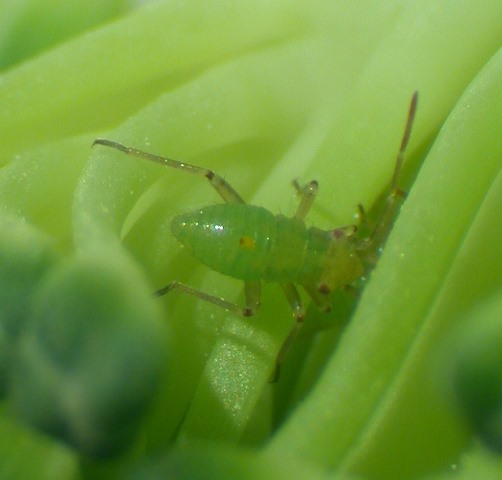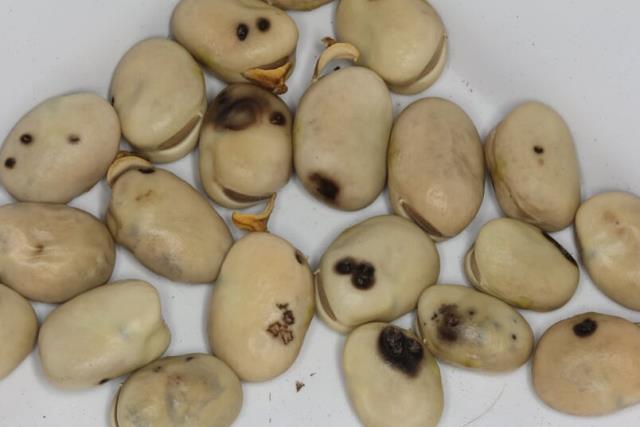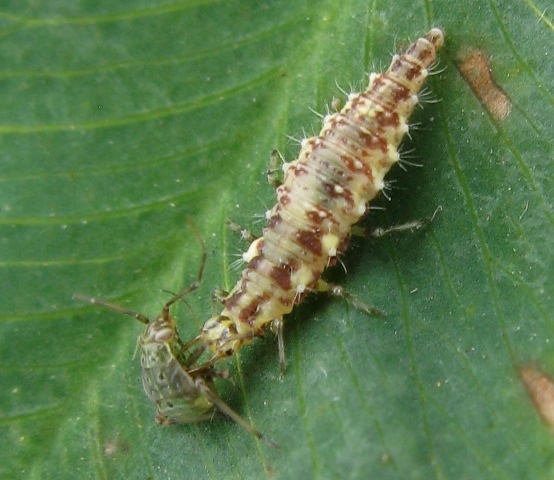Lygus Bugs in Field Crops
The term lygus bug refers to any member of plant bug in the genus Lygus. Lygus bugs have piercing and sucking mouthparts, with which they puncture plant tissues, inject digestive enzymes, and suck the plant juices in the area. They prefer to feed on the nitrogen-rich growing points and reproductive parts of the plant such as buds, flowers and young seeds. Many plants can compensate well for feeding to buds and flowers, provided there is adequate soil moisture. Feeding on seeds can cause visible damage to the seed because of the enzymes in the saliva that are left behind.
Host Crops




Fig. 3. Lygus lineolaris fifth instar nymph Fig. 4. Lygus lineolaris adult
Figures 1 to 4 from Tharshi Nagalingam, University of Manitoba.
Biology
| May | June | July | August | September |
| Overwintering adults become active, feed, lay eggs | Nymphs feed, new adults emerge | New adults mate, feed, lay eggs, nymphs feed | Nymphs feed, new adults emerge | Adults begin to overwinter |
Sampling Techniques And Economic Thresholds
Canola
Susceptible Stages: Canola is most susceptible to lygus injury during the pod stage. Even though canola can compensate for bud and flower loss so there is no or minimal net reduction in the number of pods, seed yield can decline because of lygus injury because the plant can not compensate for collapsed seeds. Research in Alberta found that low levels of lygus bug feeding from bud to early flower stage induced greater branching and thicker stems compared to plants without lygus bugs, and may increase seed yield.
Monitoring: Thresholds are based on the number of lygus bugs sampled per 10 net sweeps (with a 38 cm diameter sweep net). Sampling should ideally be done in the late morning or early afternoon after the dew has evaporated, when lygus bugs are active in the upper part of the canopy. Canola should be sampled as flowering ends (stage 4.4), particularly if precipitation is low. If densities are near but less than the threshold at stage 4.4, canola should be resampled at stage 5.1 (when seeds in the lower pods are full size, translucent). If densities are sufficiently high, control is still warranted at stage 5.2 (seeds in lower pods green). The first two instars are not taken into account in the economic threshold calculations, because they do not appear to have the ability to puncture the seed.
Lygus bug densities should be determined from a minimum of 15 samples of 10 sweeps or 10 samples of 20 sweeps per field. Samples can be collected from along the edge or at right angles from the edge of the field. Research has shown that samples taken along the edge of commercial fields and at various distances into the field all gave similar estimates of plant bug density. Sampling along the edge reduces effort during years when thick crop growth impedes access to the field. For edge sampling, the area selected for sampling should be at a crop stage similar to that in the main part of the field.
Economic thresholds when flowering is complete in canola are calculated based on an assumed loss of 0.1235 bu/acre for each lygus bug per 10 sweeps.
| Application Cost | Flowering Complete (Canola Crop Stages 4.4 - 5.1)1 | |||||||
| $ / ha | $/ ac | Economic Injury Level (Mean per 10 sweeps) | ||||||
| 22 | 8 | 11 | 8 | 7 | 5 | 5 | 4 | |
| 25 | 10 | 13 | 10 | 8 | 7 | 6 | 5 | |
| 27 | 12 | 16 | 12 | 10 | 8 | 7 | 6 | |
| 30 | 14 | 19 | 14 | 11 | 9 | 8 | 7 | |
| 32 | 16 | 22 | 16 | 13 | 11 | 9 | 8 | |
| 35 | 18 | 24 | 18 | 15 | 12 | 10 | 9 | |
| Canola Price ($/bu) | 6 | 8 | 10 | 12 | 14 | 16 | ||
Economic threshold at pod ripening in canola are calculated based on an assumed loss of 0.0882 bu/acre for each lygus bug per 10 sweeps.
| Application Cost | Pod Ripening (Canola Crop Stage 5.2)1 | |||||||
| $ / ha | $/ ac | Economic Injury Level (Mean per 10 sweeps) | ||||||
| 22 | 8 | 15 | 12 | 9 | 8 | 7 | 6 | |
| 25 | 10 | 19 | 14 | 11 | 10 | 8 | 7 | |
| 27 | 12 | 23 | 17 | 14 | 11 | 10 | 9 | |
| 30 | 14 | 27 | 20 | 16 | 13 | 11 | 10 | |
| 32 | 16 | 30 | 23 | 18 | 15 | 13 | 11 | |
| 35 | 18 | 34 | 26 | 20 | 17 | 15 | 13 | |
| Canola Price ($/bu) | 6 | 8 | 10 | 12 | 14 | 16 | ||
¹Crop stages of Harper and Berkencamp (1975):
4.4 is flowering complete, seeds enlarging in lower pods;
5.1 is when seeds in the lower pods are full size, translucent;
5.2 is when seeds in the lower pods are green.
When precipitation is greater than 100 mm from the onset of bud formation to the end of flowering, the plant may partially compensate for damage by lygus bugs.
Sunflowers
See the factsheet "Lygus Bugs on Sunflowers" at http://webpublishing.mbgov.ca/en/agriculture/crops/insects/Pages/lygus-bug-sunflowers.aspx for information on scouting and thresholds for lygus in sunflowers.
Flax
Adult lygus bugs move into flax from nearby host plants in July when flax produces buds and flowers. Feeding by lygus bugs can cause buds to become necrotic and abscise, and may result in flower abortion. Flax can compensate for insect injury by producing additional flowers.
Monitoring: Lygus bug levels can be assessed using a sweep net. Research in England found that lygus bugs were more numerous close to field edges in flax.
Economics of feeding: Although lygus bugs can reach high densities in flax, flax is tolerant of their feeding damage under good growing conditions. A study in Manitoba found that under good growing conditions, populations of up to 100 per 10 sweeps were not economical. Whether this tolerance extends to flax growing under less favourable conditions in uncertain.
Alfalfa Seed
Susceptible stages: Reduced seed yield is usually from damage to flowers and young seeds. Feeding can cause shrunken, nonviable seed.
Monitoring: In fields of alfalfa for seed, make five 180º sweeps with a 38 cm (15-inch) insect net through alfalfa canopy at each sampling site. Record total number of plant and lygus bugs (both nymphs and adults) captured. Calculate average number per sweep.
Economic thresholds in seed alfalfa are:
8 lygus bugs/sweep (40 in 5 sweeps) or 4 alfalfa plant bugs/sweep (20 in 5 sweeps) or 5 nymphs/sweep (25 in 5 sweeps) of any or all species of plant bugs, when the alfalfa is in bud or in bloom.
Chemical application should be timed so that the majority of nymphs are third instars or older.
Research in Manitoba has found that applying an insecticide in August or September to control late-season plant bugs in seed alfalfa is not economical.
Control is not recommended in alfalfa grown for hay.


Figure 5. Alfalfa plant bug adult Figure 6. Alfalfa plant bug nymph
Pulse Crops
Lentils: A nominal threshold for lygus bugs in lentils is 7 to 10 lygus bugs in 25 sweeps. Lygus bug feeding in lentils can result in pitted, crater-like depressions in the seed coat, with or without a discoloured chalky appearance. This feeding in lentils is referred to as chalky spot syndrome.
Dry Beans: Damage by lygus bugs to dry beans varies with the plant stage. Feeding at flowering to pod initiation can cause abortion of flowers or pods, although plants can sometimes compensate for the injury. During seed development and filling, feeding can cause shriveled seeds and pods and result in reduce harvested seed weight. At seed maturity, feeding on seeds can cause pits in the seed coat, which can reduce yield quality. Economic thresholds have not been established for lygus bugs in dry beans.
Faba beans: Lygus bugs can cause hull perforations in faba beans. A nominal threshold to prevent downgrading is 10 to 15 lygus bugs per 10 sweeps at the early pod stage. Pollinators are important for seed set in faba beans, and should be taken into consideration when making management decisions.

Figure 7. Lygus bug injury to faba beans.
Mike Dolinski - Sticky Wisdom Inc.
Buckwheat
Yields can potentially be reduced mainly by feeding from the lygus nymphs at the flowering stage. This feeding can result in decreased seed weight, flower and seed numbers, and increased percentages of shriveled seeds. Lygus bug populations can be monitored using a sweep net. Economic thresholds for lygus bugs on buckwheat are not available. Extra considerations are needed when applying insecticides to buckwheat that is flowering. Buckwheat requires cross-pollination, and honey bees, leafcutting bees, and other insect pollinators may be present on flowering buckwheat. Efforts should be taken to minimize harm to pollinators during flowering.
Control
Insecticides: If insecticide is required during the bloom stage, early morning or late evening applications should be targeted to minimize possible bee kill. In canola, spraying is best done at "post-petal fall" to minimize the effects of the insecticide on pollinators, which can increase yield and reduce the flowering period. Protecting pollinators is very important in alfalfa seed production, and pollination by bees is important for good yield in faba beans. The only insecticide registered for lygus bugs in field crops which is not toxic to bees is flonicamid (Beleaf), which, although not registered in canola, is registered for lygus bugs in alfalfa, faba beans and dry beans.
Planting Date: Reseaerch in southern Albeta found Lygus bugs were generally below economically damaging levels in canola fields that were seeded in April.
Weather: Heavy rainfall may reduce levels of early-instar nymphs of lygus bugs. A study in alfalfa found heavy rainfall reduced first generation nymphs of Lygus lineolaris by 50%.
Biological Control: Nymphs of Lygus bugs may be killed by parasitic wasps in the genus Peristenus (Hymenoptera: Braconidae); with parasitism being common in weedy alfalfa stands or uncultivated weedy sites but very low in canola. Damsel bugs, assassin bugs, lacewing larvae, big-eyed bugs and crab spiders can prey on lygus bugs. Protecting these natural enemies by avoiding unnecessary insecticide applications may also help to reduce the impact of lygus bugs.

Figure 8. Lacewing larva eating lygus bug
Revised February 2019
John Gavloski, entomologist, Manitoba Agriculture

